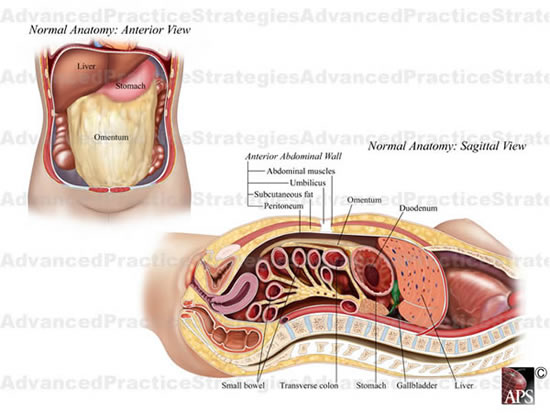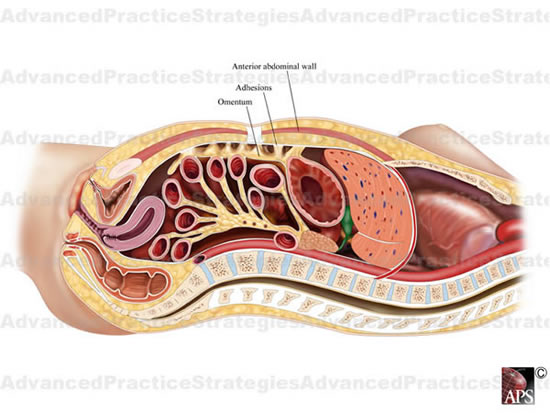Laparoscopic Enterolysis (Lysis of Adhesions)
A. The Condition. You may have a blockage in your small bowel that is caused by scar tissue. The source of this scar tissue usually is from previous surgery. Laparoscopic enterolysis will cut this scar tissue away, thus unblocking your bowels.
The first in the world laparoscopic repair of congenital duodenal obstruction due to adhesions was performed by Dr. Frantzides in 2003 and was published in 2006.
B. Symptoms
- Nausea and vomiting
- Abdominal pain
- Diarrhea
C. Laparoscopic Enterolysis. The surgeon will make about 3-4 small incisions in your abdomen. A port (nozzle) is inserted into one of the slits, and carbon dioxide gas inflates the abdomen. This process allows the surgeon to see inside of your abdomen more easily. A laparoscope is inserted through another port. The laparoscope looks like a telescope with a light and camera on the end so the surgeon can see inside the abdomen. Surgical instruments are placed in the other small openings and used to cut the scar tissue in order to relieve the obstruction. This type of operation can be demanding and time-consuming to perform, especially if there is a large amount of scar tissue. In some cases, a diseased portion of the small bowel may need to be removed. This would be done with surgical staplers, and the bowel would be re-connected so that you could eat. If a segment of bowel does need to be removed, then it is extracted from the abdomen through one of the small incisions. After all this has been accomplished, the carbon dioxide is released out of the abdomen through the slits, and then these sites are closed with sutures or staples, or covered with glue-like bandage and steri-strips.
D. Nonsurgical Treatment. Sometimes a bowel obstruction can be treated by suctioning out the contents of the stomach, giving IV fluids, and not letting the patient eat for a few days. If you have a mass or tumor in the small bowel that is causing the obstruction, then this is best treated with surgery.
E. Risks. The primary risks of laparoscopic enterolysis are:
- Infection of the skin at one of the small ports sites
- Collection of pus inside your abdomen (intraabdominal abscess)
- Postoperative ileus (the intestines slow down/stop working for several days)
- Recurrent small bowel obstruction
F. Expectations
1. Before Your Operation. Laparoscopic enterolysis is usually not an elective procedure. The preoperative evaluation might include blood work, urinalysis, abdominal x-rays, and an abdominal CT scan. You also may have a barium x-ray of your small bowel. Your surgeon and anesthesia provider will review your health history, medications, and options for pain control.
2. Your Recovery. You usually can go home 1 to 2 days after a laparoscopic small bowel enterolysis. You may have to wait for your bowels to start working You will be given medication for pain, and you may be given antibiotic pills. You should limit your activity to light lifting (no more than 15 lb) for one month.
3. Call Your Surgeon if you have one or more of the following:
- Severe pain
- High fever
- Odor or increased drainage from your incision
- No bowel movements for three days
- Nausea, vomiting, and/or crampy abdominal pain
G. Pertinent References.
Zeni T, Bemelman WA, Frantzides CT. Minimally Invasive Procedures on the Small Intestine. In: Frantzides CT, Carlson MA, eds. Atlas of Minimally Invasive Surgery. Philadelphia: Saunders Elsevier, 2009.
Frantzides C. T, Madan A. K, Laparoscopic repair of congenital duodenal obstruction J. Laparoendsc.&Adv.Surg.Tech. 16 (1) : 48-50, 2006.

